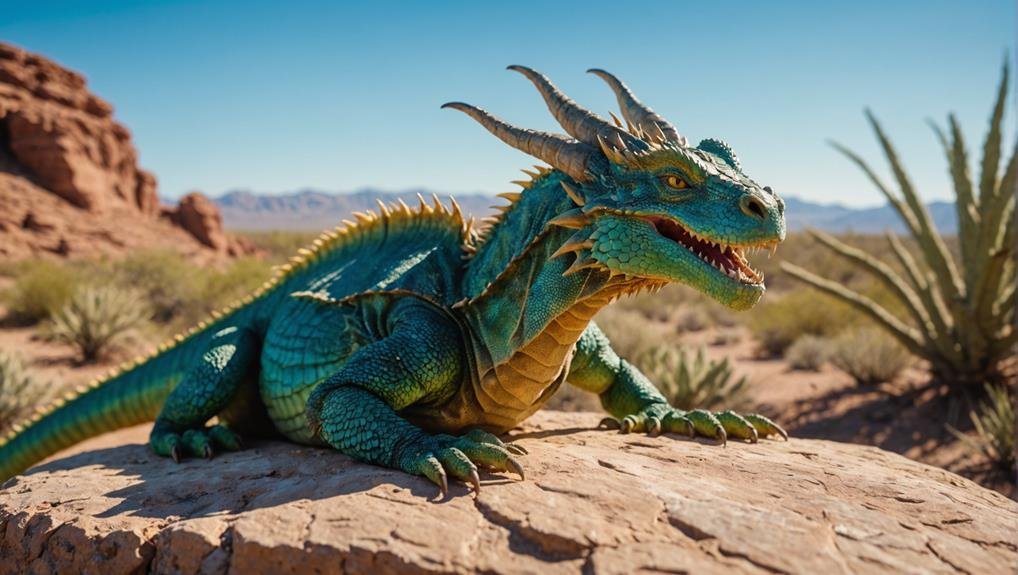When you consider adding a unique pet to your home, a Rankins Dragon might catch your interest. Native to the arid regions with rocky outcrops, these small reptiles are known for their triangular heads and scale-covered chins, which give them a distinct appearance. Their friendly and curious nature makes them great companions, but their needs must be considered. From diet and nutrition to housing requirements, there’s much to ponder if you plan to care for one. So, what exactly does it take to guarantee these fascinating creatures thrive?
Key Takeaways
- Rankins dragons are small, friendly reptiles thriving in hot, dry, rocky environments.
- They require a 40-gallon tank with UVB lighting, climbing structures, and hiding spots.
- Their diet includes a mix of insects and vegetables, with occasional fruits as treats.
- Regular, gentle handling from a young age helps form strong bonds with owners.
- Common stress indicators include dark colouration, frequent hiding, and loss of appetite.
Origin and Natural Habitat
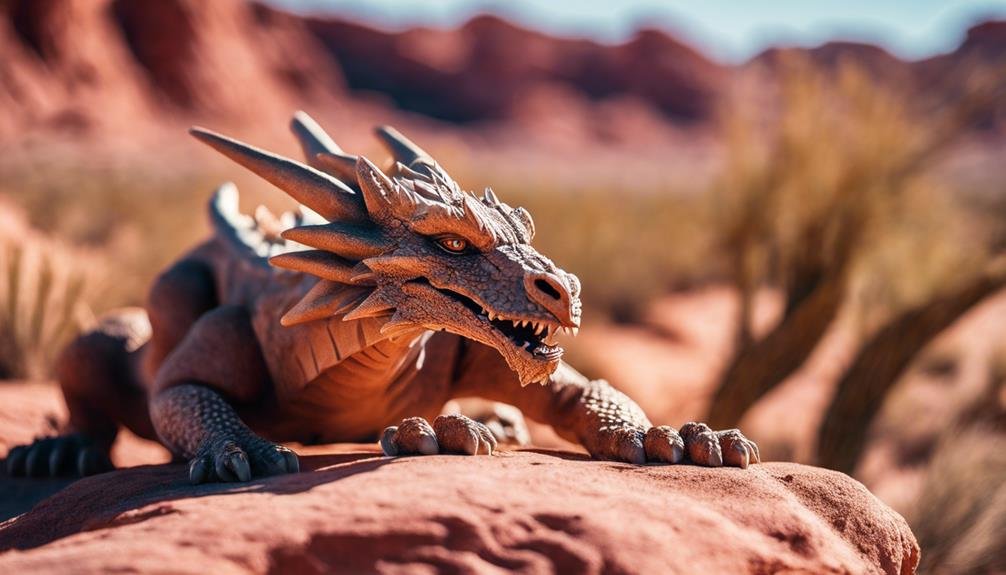

Rankin’s dragons, native to Queensland, Australia, thrive in the region’s hot, dry, and rocky environments. When you explore their natural habitat, you’ll notice that these landscapes provide the perfect conditions for Rankins dragons, also known as Lawson’s, Dumpy, or Pygmy dragons.
They prefer arid areas with plenty of rocks and sparse vegetation, offering ample basking spots and hiding places. In their natural habitat, Rankins dragons can often be seen sunning themselves on rocky outcrops or darting between crevices to avoid predators.
Unlike their larger bearded dragon cousins, these smaller reptiles have adapted incredibly well to the harsh Australian outback. Their agility and smaller size allow them to easily navigate the rugged terrain, making the most of the limited resources available.
Rankins dragons have also adapted to life in captivity, where they’re now commonly found worldwide. Despite being descendants of illegally exported dragons from the 1980s, they’ve become popular pets due to their manageable size and friendly demeanour.
If you’re considering one as a pet, understanding their natural habitat will help you create a more suitable and enriching environment for them.
Physical Characteristics
When observing the physical characteristics of Rankin’s dragons, you’ll notice their distinct triangular head shape and lack of the spiky beard found in bearded dragons. Instead, they’ve scales on their chin, which adds to their unique appearance.
Although baby Rankin’s dragons resemble baby bearded dragons, their heads are narrower, even at an early age. As they grow, they maintain a smaller size, another notable difference from the larger bearded dragons.
Rankin’s dragons are easily distinguishable due to their:
- Triangular head shape: This feature sets them apart from the more rounded heads of bearded dragons.
- Scales on their chin: Unlike the spiky beard seen in bearded dragons, these scales are less pronounced but still notable.
- Smaller overall size: They remain smaller than bearded dragons throughout their lives.
- Narrower heads in juveniles: You can spot the narrower head shape in Rankin’s dragons, even as babies.
- Lack of spiky beard: One of the most distinguishing features is the absence of a prominent beard.
These physical characteristics make Rankin’s dragons a unique and fascinating species. They are easily recognizable by their head shape, scales, and size differences.
Common Names
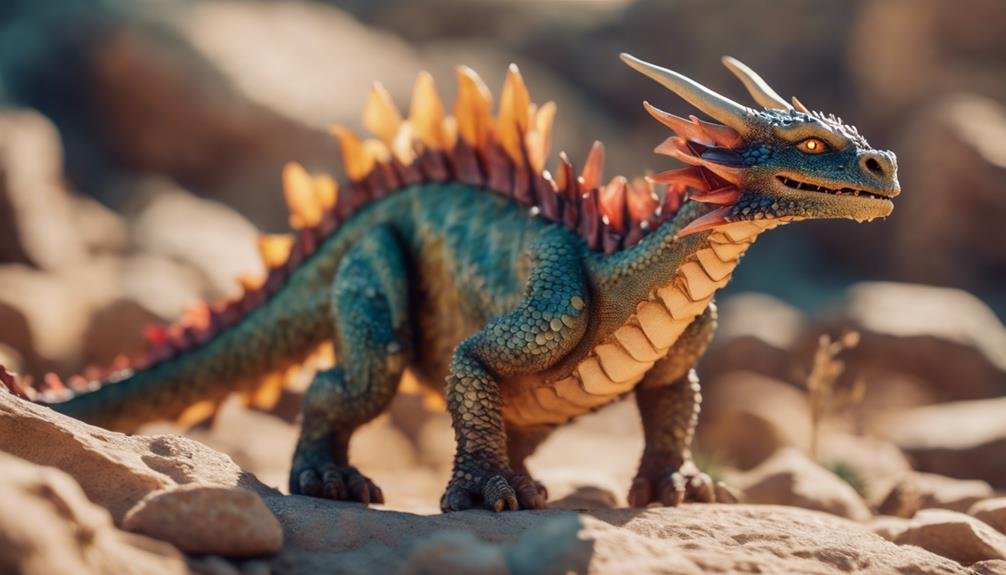

When talking about Rankin’s dragon, you’ll notice it goes by several common names like Pygmy and Dumpy. These names often reflect their size, appearance, or origin, helping enthusiasts identify them easily.
Let’s explore how these popular pet reptiles got such varied names and what they reveal about the species.
Popular Pet Reptile
Among the many names pet enthusiasts use, you’ll often hear Rankin’s dragons referred to as Lawson’s dragons, dumpy dragons, pygmy dragons, dwarf bearded dragons, or black soil bearded dragons. As a popular pet reptile, these charming creatures have garnered attention worldwide.
Originally from Queensland, Australia, they thrive in captivity worldwide. Their manageable size and docile nature make them a favourite among reptile lovers.
Rankin’s dragons closely resemble their larger cousin, the central bearded dragon, but they typically grow under 30 cm in total length, with a shorter, more blunt snout. If you’re considering adding one to your home, here are some key traits:
- Size: Compact, generally under 30 cm
- Appearance: Shorter snout and more blunt features compared to central bearded dragons
- Habitat: Native to Queensland, Australia, but adaptable in captivity
- Temperament: Docile and easy to handle
- Popularity: Rising in the pet reptile community due to their manageable size and friendly demeanour
Rankin’s dragons in captivity today are believed to be descendants of those illegally exported in the 1980s, contributing to their global presence.
Scientific Name Origins
The scientific name of Rankin’s dragon has sparked considerable debate, with some experts considering it synonymous with Pogona brevis. This dispute over the origin of scientific names has created confusion within the herpetology community.
The taxonomy of Rankin’s dragon has been under scrutiny since its formal description in 1985. Harold Cogger’s 2000 publication of ‘Rankinia’ added another layer of complexity to the already contested classification.
You might wonder why such a small reptile would cause such a stir among scientists. The crux of the issue lies in its close resemblance to other Pogona species, making it challenging to delineate clear taxonomic boundaries.
Some herpetologists argue that the differences between Rankin’s dragon and Pogona brevis are too minimal to warrant separate species status. This has led to the disputed view that Rankin’s dragon should be classified under the Pogona Brevis umbrella.
Despite the ongoing debate over its scientific name, Rankin’s dragon remains a beloved species in the pet trade. Its popularity ensures that the discussion around its taxonomy is far from over as enthusiasts and scientists seek clarity on its proper classification.
Regional Nicknames
Despite the ongoing debate over its scientific name, Rankin’s Dragon boasts a variety of regional nicknames that reflect its unique characteristics and widespread popularity. These nicknames highlight its distinctive traits and underscore its significant presence in the pet trade and captive breeding programs.
Several regional names commonly know Rankin’s dragons, each offering a glimpse into different aspects of their nature:
- Lawsons dragon
- Dumpy dragon
- Pygmy dragon
- Dwarf bearded dragon
- Black soil bearded dragon
Each of these nicknames emphasizes specific characteristics of Rankin’s dragons. For instance, ‘Lawson’s dragon’ pays homage to the person describing the species, while ‘Dumpy dragon’ and ‘Pygmy dragon’ highlight its smaller, more compact size than other bearded dragons.
The term ‘Dwarf bearded dragon’ further illustrates its petite stature, making it an appealing choice for pet enthusiasts with limited space. Meanwhile, ‘Black soil bearded dragon’ points to its natural habitat, providing insight into its ecological preferences.
These regional nicknames help differentiate Rankin’s dragons from their larger counterparts, making them popular pets that captivate reptile enthusiasts worldwide.
Behaviour and Temperament
When you bring a Rankin’s dragon home, you’ll quickly notice their friendly and curious nature. They enjoy social interactions and can form strong bonds with regular, gentle handling.
Recognizing stress indicators, such as decreased activity or hiding, guarantees your dragon remains happy and healthy.
Social Interaction Patterns
Rankin’s dragons thrive on social interactions, making them delightful companions for pet owners. Their social interaction patterns reveal a friendly nature that makes bonding with them enjoyable and straightforward. You’ll often find them basking in the sun or perched on your shoulder, demonstrating their calm and docile behaviour. This friendly nature allows you to handle and engage with them regularly, creating a strong bond over time.
Here are some key social behaviours to look for:
- Basking together: Rankin’s dragons often bask in groups, showcasing their social tendencies.
- Perching on shoulders: They love climbing and resting on their owner’s shoulders, a sign of trust and comfort.
- Feeding interactions: Observing their behaviour during feeding can provide insights into their social hierarchy and manners.
- Calm demeanour: Their relaxed and gentle temperament makes them approachable and easy to interact with.
- Curiosity: They exhibit a curious nature, eagerly exploring their surroundings and engaging with their environment.
Understanding these social interaction patterns can enhance your experience as a pet owner and help you create a nurturing environment. By observing your Rankin’s dragon’s friendly nature and bonding habits, you can ensure it remains happy and healthy.
Handling and Bonding Tips
Understanding their behaviour and temperament builds a strong bond with your Rankin’s dragon. These dragons are known for their friendly and docile nature, which makes them easy to handle and bond with.
One thing you should keep in mind is that regular, gentle handling from a young age is crucial to building trust. Spend a little time each day hand-feeding, gently petting, and simply being near your dragon to help them become accustomed to your presence.
Your Rankin’s dragon enjoys human interaction and can become quite affectionate towards you. Positive interactions and consistent handling will help develop a close bond and a trusting relationship.
Each time you handle your dragon, be gentle and calm. If your dragon seems hesitant, go slowly and let them come to you at their own pace.
Next time you interact with your Rankin’s dragon, remember that patience and consistency are key. The more you engage in bonding activities, the stronger your relationship will become.
Stress Indicators Signs
Spotting stress in your Rankin’s dragon early is essential to maintaining their health and well-being. By identifying stress indicators, you can address issues before they escalate into serious health problems. Signs of stress in Rankin’s dragons include noticeable behaviour and physical appearance changes. Dark colouration, frequent hiding, loss of appetite, and engaging in glass surfing are common indicators. Recognizing these signs makes managing your pet’s stress much easier.
Your Rankin’s dragon may also display behavioural indicators such as aggression, tail wagging, and puffing up. Changes in their activity levels, whether decreased movement or excessive pacing, are also red flags. Stress can lead to a weakened immune system, digestive problems, and increased susceptibility to diseases, so it’s important to act swiftly.
To help your Rankin’s dragon feel more comfortable, consider the following adjustments:
- Ensure proper temperature and lighting in their habitat.
- Provide adequate hiding spots for them to retreat to.
- Regularly monitor their diet and hydration.
- Minimize noise and disturbances around their enclosure.
- Handle them gently and infrequently to avoid unnecessary stress.
Diet and Nutrition


Ever wonder what makes up a balanced diet for a Rankin’s dragon? Their feeding schedule and nutrient intake are important for their health.
As omnivores, they need a mix of insects like crickets, roaches, and mealworms to meet their protein needs. To ensure they get all the necessary nutrients, you should also offer a variety of vegetables, such as dark leafy greens, squash, and bell peppers.
Meal prep is vital for maintaining dietary balance. Dusting their food with calcium and vitamin supplements can prevent deficiencies, especially in young dragons. Fresh water should be available daily, though they get most of their hydration from food.
Rankin’s dragons have different dietary needs at various growth stages. Hatchlings and juveniles require more protein for growth, so you should offer insects daily.
As they mature, you can reduce the frequency of insect feedings and increase the amount of vegetables. This shift matches their changing dietary needs and helps prevent obesity.
Housing Requirements
When establishing a habitat for your Rankin’s dragon, ensure the tank is at least 40 gallons to give them enough space to move and bask comfortably. A well-planned enclosure size ensures your dragon has ample room to thrive.
Focus on tank decor and temperature regulation to create an ideal environment. Include a variety of climbing structures, like branches and rocks, to let your dragon exhibit natural behaviours and explore. Hiding spots are essential, too, providing your pet with places to feel secure.
For lighting options, make sure you have UVB lighting to help your dragon synthesize vitamin D3, which is important for their bone health. A basking light is also necessary to create a temperature gradient within the tank. Proper temperature regulation involves maintaining a range of 75-85°F.
Consider reptile carpets, paper towels, or non-adhesive shelf liners regarding substrate choices. These options are easy to clean and reduce the risk of impaction.
It’s also vital to maintain appropriate humidity levels. Aim for 30-40% to mimic their natural habitat and support their overall well-being.
Health and Wellness
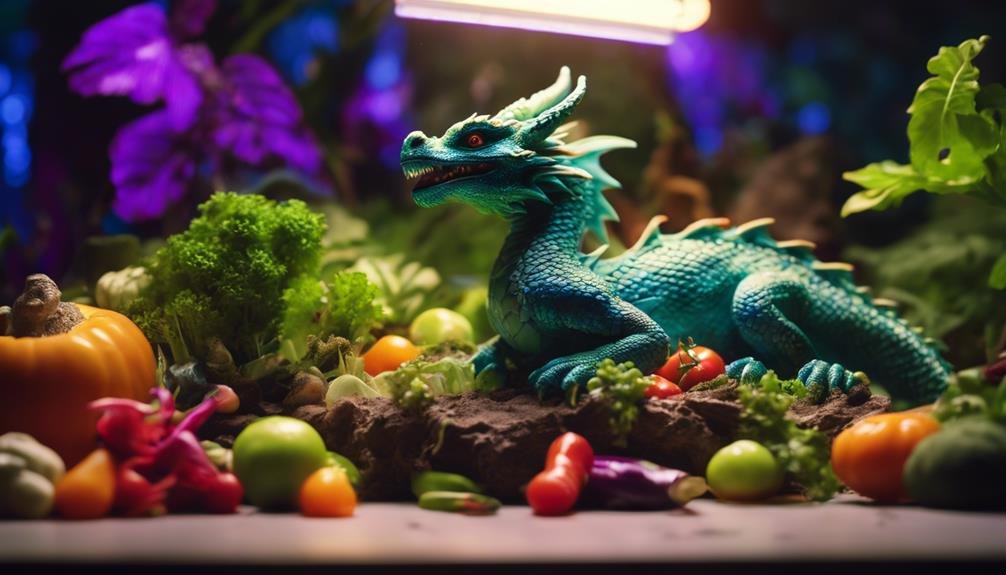

Ensuring the health and wellness of your Rankin’s dragon involves a balanced diet, proper lighting, and regular veterinary check-ups. A well-rounded diet featuring insects, leafy greens, and vegetables is essential for their growth rates and overall vitality. Make sure to offer a variety of foods to meet their nutritional needs and prevent health problems like malnutrition.
Regular exposure to UVB lighting is important. It helps your dragon metabolize calcium, preventing metabolic bone disease. Place the UVB light within 12-18 inches of your dragon’s basking spot, maintaining temperatures around 95-100°F. This enables them to regulate body temperature and aids in digestion.
Humidity levels should stay between 30% and 40%. Higher humidity can lead to respiratory infections. Monitor this using a hygrometer and adjust as needed. Regular veterinary check-ups will help catch potential health problems early, ensuring your Rankin’s dragon stays in excellent condition.
Lastly, they provide environmental enrichment within their enclosure. This includes climbing structures, hiding spots, and varied terrain. Engaging their physical and mental faculties will promote healthy behaviour and prevent stress. Proper care and attention to these details will help your Rankin’s dragon thrive.
Breeding and Lifespan
Rankin’s dragons typically reach sexual maturity between 8 and 12 months, making this the opportune time to contemplate breeding. Their breeding habits usually peak during warmer months, and females can lay clutches of 6-20 eggs per breeding season. Understanding their reproductive cycles is vital for ensuring the longevity and sustainability of the species.
To help you manage their breeding and lifespan better, here are key points to contemplate:
- Mating behaviours: Rankin’s dragons exhibit specific rituals, such as head-bobbing and arm-waving, to attract mates.
- Incubation period: The eggs take about 55 to 75 days to hatch.
- Lifespan: Rankin’s dragons live an average of 6 to 8 years in captivity.
- Population dynamics: Monitoring breeding can help maintain a stable population in captivity, aiding conservation efforts.
- Aging process: Regular health checks can help manage aging-related issues, contributing to their overall longevity.
Understanding these aspects supports healthy breeding practices and sustainability of conservation and species. By managing their reproductive cycles and lifespan effectively, you play a pivotal role in maintaining the population dynamics of Rankin’s dragons.
Tips for New Owners
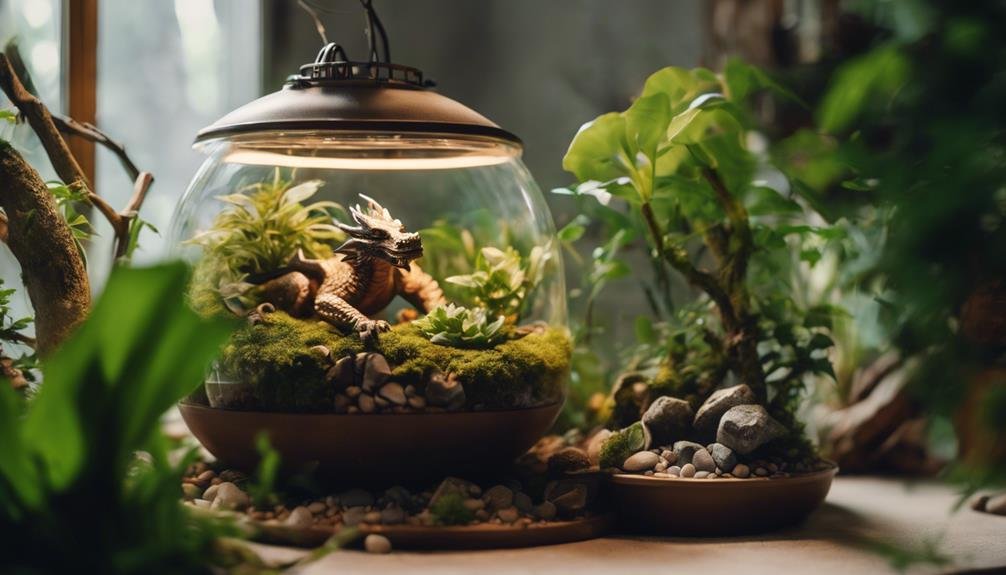

Starting with a Rankin’s dragon requires creating a suitable habitat that mimics their natural environment. A 40-gallon tank with a hot, dry, and rocky setup is essential. Include plenty of hiding spots for them to feel secure. Rankin’s dragons are social creatures, so consider cohabitating them to make care easier.
For a proper habitat setup, ensure the tank is well-ventilated and has a basking spot at about 95°F (35°C). The cooler end should be around 75°F (24°C). UVB lighting prevents metabolic bone disease, which they’re susceptible to. Substrate choices like reptile carpets or tiles are ideal to avoid ingestion issues.
It is important to feed your Rankin’s dragon a varied diet. Follow a feeding schedule that includes insects like crickets and mealworms and vegetables like leafy greens. Offer occasional fruits as treats. This ensures they receive balanced nutrition.
Handling your Rankin’s dragon regularly and gently helps build trust and strengthens your bond. Observe their health closely and consult a vet if you notice any signs of illness. With these care tips, your Rankin’s dragon will thrive in its new home.
Conclusion
Taking care of a Rankins Dragon can be a rewarding experience. You’ll guarantee your pet stays healthy and happy by providing proper housing, a balanced diet, and regular handling.
To mimic their natural habitat, please consider their unique needs, like UVB lighting and climbing structures. With their friendly and curious nature, you’ll quickly form a strong bond.
Remember these tips, and you’ll be a great Rankins Dragon owner!
FAQs
1. Are Rankins Dragons Good Pets?
Evaluating pets involves temperament assessment, dietary needs, and habitat setup. Rankin’s dragons excel in all these areas. They’re friendly and easy to feed, and their habitat is simple to maintain, making them excellent pets for beginners.
2. What Is the Difference Between a Bearded Dragon and a Rankins Dragon?
You’ll notice differences in physical characteristics, habitat preferences, and dietary needs. Bearded dragons are larger with spiked beards, while Rankin’s are smaller and have different scales. Both have similar habitats and diets but distinct lifespans.
3. How Big Does a Rankins Dragon Get?
Rankin’s dragons grow up to 12 inches. Make sure their tank setup is at least 40 gallons. Their diet requirements include insects and veggies. They exhibit social behaviour, often more docile and interactive than larger dragons.
4. How Long Does a Rankin Dragon Live?
A Rankin’s dragon typically lives 6 to 8 years. You can maximize its lifespan by ensuring proper diet requirements, an ideal habitat setup, and understanding its breeding habits. Proper care is essential for their longevity.
Related Article
https://thereptileguide.com/leopard-gecko-diet/
https://thereptileguide.com/albino-corn-snake/

